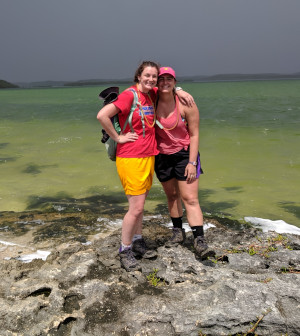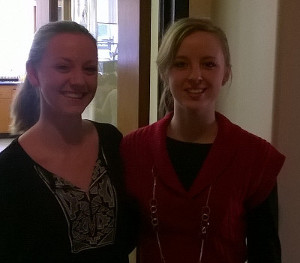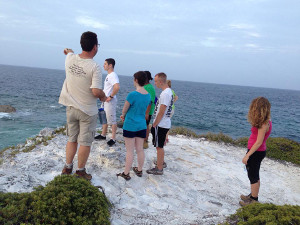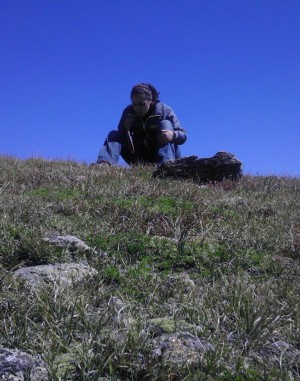
|
|||
|
Student Research in the Kjar lab:
|
||
|
Emilty Breheny and Lauren Franklin |
||
 |
Emily and Lauren worked with me in the Bahamas and on campus developing a new means of trapping ants using 3d-printed pitfall traps. They spent two weeks during the summer of 2019 on the island of San Salvador the Bahamas catching, pinning, and identifying ants. They also presented their research at the 3rd Joint Symposium on the Natural History and Geology of the Bahamas at the Gerace Research Centre. |
|
|
Andrew Reed and Will Jenkins |
||
 |
Andy and Will worked on isolating DNA samples from 18 colonies of Paratrechina longicornis collected during the 2017 research trip to the Bahamas. They also worked with me on creating the phylogeny based on previously collected colonies. They presented their work at the Bahamas National Trust conference in Nassau, The Bahamas in 2018. |
|
|
Ashley Miller and Bridget Yaw |
||
 |
Ashley and Bridget worked in my lab on amplifying and characterizing microsatellite markers in Paratrechina longicornis and joined me for the 2017 Gerace Research Centre conference on San Salvador. After presenting our work on the genotyping of the crazy ants they spent two weeks on the beaches and in the bush (their favorite part) of San Salvador Island, The Bahamas studying ant behavior at baits. We were also able to finally find queens in a Dorymyrmex antillanus, and determined this species is polygynous. |
|
|
Julien Hockenburger and Alexis Devenpeck |
||
 |
Julien and Alexis worked with me on a project to try and determine if Dorymyrmex antillanus had polygynous nests (multiple active queens). Although we spent days digging our way through the beaches of San Salvador Island, we were unable to locate queens. We did document nest structure and the interconnectivity of nests. |
|
|
Rachel Seweryniack and Katielyn Slaver |
||
 |
Rachel graduated from Elmira College in 2016. She is now working on her Doctorate of Osteopathic Medicine at Lake Erie Osteopathic School at the Bradenton, Florida campus.
Rachel and Katie are working on the protocols that Jessica Hassan created to isolate genes from Paratrechina longicornis and are now in the process of amplifying and sequencing micro-satellite markers. We will use several markers to determine relatedness among behaviorally distinct populations of P. longicornis on San Salvador Island the Bahamas. |
|
|
Zachary Park |
||
 |
Zachary graduated from Elmira College in 2017. He is now at Georgetown University working on a PhD in Dr. Mark Rose's lab (Molecular Biology).
Zachory Park and I wrote a paper on invasive plant impact on an ant community in Virginia, published in the journal Myrmecological News. We then worked on statistical analysis of our ant behavior work from 2014, 2015, and 2017 in the Bahamas. We have completed that manuscript and it is now in review. While working with me he has developed ways to analyze our data using BIC (Bayesian Information Criterion), AIC (Akaike Information Criterion), and linear models using the statistical software R. Besides joining me on San Salvador as a research student, Zack also presented his work at conferences in Nassau, The Bahamas, and Baltimore, Maryland. |
|
|
Summer Research 2015 |
||
 |
For three weeks during June, 2015, Rachel Seweryniack 16' and Katelyn Slaver 17' joined me (and 11 other research students and Elmira College science faculty) in research on San Salvador Island, The Bahamas. We continued to evaluate ant competitive behaviors at baits. We also attended the 1st Joint Natural History and Geology Conference at the Gerace Research Centre. Our students presented their research at the conference. | |
 |
Staring at ants in a tropical paradise. | |
 |
Paratrechina longicornis at a bait. | |
 |
Long nights in the lab pinning ants. | |
 |
International travel with a deep tan. | |
 |
We did not find any ants here. | |
 |
It's not all work. | |
|
Jessica Hassan |
||
 |
Jessica graduated in 2015 and began working on an MD at SUNY Upstate Medical College in Syracuse, NY.
Jessica Hassan 15' worked with me on my ant genetics work for 3 years while at Elmira College. She developed the protocols that we now use to isolate genes from Paratrechina longicornis and was able to get sequences from micro-satelite markers in Tetramorium caespitum (our test ant of choice). Rachel Seweryniack and Katelyn Slaver have now taken over this work and are using these methods to look at our Bahamaian ants. |
|
|
Summer Research 2014 |
||
 |
For two weeks during June, 2014, Kayla Heintzleman 16', Brandon Davis 17', Diana Lutz 17', Charlea Smith 17', and Zachary Park 17' took part in the Elmira College Summer Research Program and traveled to San Salvador Island, The Bahamas. I led the research with help from Dr. Betsy Smith and Marcia Metcalfe. The students and faculty stayed at the Gerace Research Centre and traveled throughout the island to conduct observations. The students spent hours in the field each day monitoring competitive interactions among ant species. The research explored ant species interactions and how particular environments affect the outcomes of these interactions. By observing the behavior of ants at baits placed in the field, a variety of important influences on the ant community can be understood; in particular, if isolation of ant species to particular habitats may be due to competitive interactions and how those interactions change due to temporal and environmental changes. An important aspect of this research is determining the effect of non-native ant species on the outcome of competitive interactions. The students spent their days recording data in the field and their evenings curating and identifying the ants we observed during the day. Dr. Betsy Smith and I presented a summary of the results of the 2014 research during the 1st Joint Natural History and Geology of the Bahamas conference during the June of 2015. | |
 |
Hike to North Point on our first day on the island. | |
 |
On the way to our first field day. | |
 |
Hiking to one of our field sites on the Island. While at this site we collected a beetle that may be a new species of Staphlinidae. Specialists in the U.S. and Germany are now examing the specimen. | |
|
Chelsea Zorn |
||
 |
Chelsea is now at the University of Missouri College of Veterinary Medicine working towards her DVM.
Chelsea joined my lab in 2012 to help pin and identify ants from my October 2011 Saguaro National Park collecting event. During the August of 2012 Chelsea and I traveled to Rocky Mountain National Park for a 3 day collecting adventure during for the National Geographic Society and National Park Service Bioblitz. We collected, pinned and identified 22 species of ants from altitudes ranging from 8000 to 12,200 feet. |
|
 |
This picture was taken at 12,207 feet in the Rocky Mountain National Park. At this point we are above the tree line and are deep in the tundra. We were able to find at least one ant species up to 12,100 feet but none above that altitude in this area of the park. | |
|
Teria Bain |
||
 |
After working in a biomedical company in Albany, New York. Teria, a Bahamian, is now working towards her M.D. at the University of the West Indies.
Teria took part in our 2012 summer research program at Elmira College. Teria was extremely productive and made great progress on several projects that I have been working on since the days of Kimmy Kellett (back in 2008). She created a protocol to quantify DNA in a sample using our new Carey Eclipse Flourimeter (we now have a new nano-drop reader). Teria was then finally able to get excellent PCR amplification of cytochrome oxidase from a single ant leg. We were able to extract the gene from the electrophoresis gel and, using the flourimeter to determine the quantity of DNA present in the sample, we were able to successfully complete a DNA sequencing reaction. Teria also began working on the new Agilent GCMS, continuing the 'ant smell' project. |
|
|
Alicia Barone |
||
 |
After Elmira, Alicia went to the University of Buffalo School of Dentistry and is now a DDS.
Alicia has been working with me during the 2011-2012 school year and during term III in the Bahamas. Her project is a continuation of Brendan Sanders work on predation of jimbay seeds on San Salvador Island. She has compiled a massive amount of data on seed predation and wasp predation of beetles from across San Salvador. Alicia presented her research and submitted her paper at the 15th Symposium on the Natural History of the Bahamas. She also presented a poster at the UMBC conference on undergraduate research and won 1st place in her division. |
|
|
Brendan Sanders |
||
 |
After graduation from EC in 2012, Brendan played professional hockey in Europe for a couple years and traveled the world. He has now started the MD program at The Faculty of Medicine, The University of Ottawa.
Brendan began working with Dr. Egan and I in 2009 when he enrolled in Marine and Island Ecology. While on San Salvador he collected samples of Jimbay. He has recorded seed predation events by a bruchid beetle as well as a lepidopteran. He also found a parasitoid wasp that has attacked the beetle. We have completed this work and presented this research at the 14th Symposium on the Natural History of the Bahamas. The manuscript was published in 2013. |
|
|
Kevin Stavrides |
||
 |
Kevin graduated Elmira College in 2012 and attended Drexel University College of Medicine for his MD. He is now a resident physician and Geisinger in Pennsylvania Kevin joined my lab in 2011 and worked on the ant collection as well as the Smithsonian Type Ant Database. Kevin (working with Sam Ferguson) databased all of the specimens in my ant collection which I will now use to create an searchable online database. | |
|
Henry Montilla |
||
 |
Henry graduated in 2013 and began working on his MD at the Penn State Hershey College of Medicine. Henry worked in my lab during 2010-2011. He took over for Jessica Reed and continued the hydrocarbon work until the GCMS died. We recently purchased a brand new agilent GCMS and Teria Bain continued with project during the summe of 2012. |
|
|
Jessica Reed |
||
 |
Jessica finished a 3+1 program in medical technology in 2012. She is now working for a hospital in Geneva, NY.
Jessica did research in my lab during the summer of 2010. She worked on a new project exploring the relationship among cuticular hydrocarbons and the phylogeny of the ants. She presented our work at the UMBC undergraduate research conference in the fall of 2010. Watch her describe her work on Youtube. |
|
|
Conner Scace |
||
 |
Conner finished his Masters in Environmental Science at the University of New Haven in 2013 he also recently finished a master's in education at New Haven.
Conner was a biology/environmental studies double major working on a large USDA/Johns Hopkins project exploring the impact of organic farming on arthropod communities. We counted and identicied the ants from this study. The study is a comparison of pit-fall traps from till, no till, and organic farming sites. During the summer of 2009 Conner and Jessica Phillips pinned over 3000 ants and counted a total of 9022 ants as part of this study. |
|
|
Jessica Phillips |
||
 |
Jessica finished a Masters program in Ecology, Evolution, and Animal Behavior at the University of Connecticut in 2013. She went on to fork for an Exotic Feline Rescue center (playing with tigers) for several years. Now she is working as a scientist at an in vitro clinical diagnostics company but still does the animal thing at a local animal hospital.
Jessica was a biology major working in my lab on the USDA/Johns Hopkins project. Along with her and Conner's work on the farm ants they were also working on perfecting the isolation and amplification of genes from small amounts of ant tissue. They both worked in my lab during 2010 to try and finish the molecular work as well as help in writing the publication for the USDA data. This work was presented as a poster at the most recent IUSSI meeting in Copenhagen Denmark. Conner and Jessica both helped collect specimens at two bioblitzes near the Patuxent River during the spring of 2009. They also worked with me on the Bahamian insect database, adding over 900 beetles. Jessica worked very hard helping to edit and perfect the manuscript which will be published in 2011. |
|
|
Gabriel Sackett |
||
 |
Gabe Sackett graduated with a Bachelors in Biology in 2009. He worked with me extensively on collecting and identifying ants. Gabe is now working towards becoming an officer in the New York Department of Environmental Conservation. | |
 |
Gabe was a great help at the National Geographic Bioblitz at Indiana Dunes National Lakeshore in the spring of 2009. There is nothing quite like pinning ants in 40 degree weather while sitting in a puddle. Gabe also worked with me on San Salvador Island in the Bahamas. We completed a survey of all literature records of Bahamian insects at the Gerace Research station. This project grew into an online database of Bahamian insects and I presented the survey as a poster during the 13th Symposium on the Natural History of the Bahamas during June of 2009. This database currently contains 1739 species with 2186 species records. |
Tessa Brennan |
|
|
Tessa graduated in 2009 and worked in John Losey's lab at Cornell University during the summer. She is now applying to research positions in Los Angelos. During my junior year I did research with Dr. Kjar. My research focused on comparing ant community diversity from high and low elevations in Western New York. This research project gave me experience in the laboratory as well as extensive field work. |
|
 |
Through this project I was also able to attend National Geographic's 2008 BioBlitz in Santa Monica, California. This event was a 24-hour species inventory in the Santa Monica Mountains. This bioblitz gave me the opportunity to connect with other scientists and learn about the local plant and animal species in southern California. |
|
|
Megan Klopfer |
||
|
|
Megan graduated in 2009 with a Bachelors in Biology, completed medical school at SUNY Upstate, Syracuse, and is now headed to a residency at Brown University. I worked on the Smithsonian Formicid Type Database. I now have a basic understanding of database programming, and I have become proficient at doing historical descriptive literature analysis and inputting type specimen information. During the summer of 2008, I was granted a Deutscher Akademischer Austausch Dienst Research Internships in Science and Engineering (RISE) Scholarship to work on a research project in Germany. I spent ten weeks working in tandem with a German PhD student on a hydrobiology project investigating the effects of the parasite Ligula intestinalis in species of wild roach. This experience allowed me not only to further refine my clinical skills but also enhanced my ability to relate to people from a variety of cultural backgrounds. |
|
|
Hailey Collier |
||
|
|
Hailey graduated from Elmira College in 2008 with a Bachelors degree in Biology. She recieved her degree in Pharmacy from the Massachusetts College of Pharmacy and Health Sciences. Currently Hailey is a Clinical Pharmacist at the Children's Hospital of Philidalphia. I conducted various studies on ant diversity and distribution in Elmira, New York. I designed pitfall traps and outlined the methods for the collection of ant species. I conducted an introductory investigation of ant species found at the Tanglewood Nature Center in Elmira, New York. I did a rapid assessment of the qualitative differences in the ant communities in various local habitats. Lastly, I aided in re-establishing the entomology collection at Elmira College which had been abandoned in the early 1950's. |
|
| I also attended the University of North Carolina at Chapel Hill bioblitz at Mason Farm Biological Reserve. We explored the woods of Mason Farms examining species diversity and enjoying the natural world. We were able to obtain several ants species for the the newly established entomology collection, including a North American Army Ant (Neivamyrmex). I was able to contribute both my knowledge and experience to the collection and identification of an assortment of ant species collected. | ||
|
|
I had the opportunity to work with Dr. Kjar as a teaching fellow in a Field Biology course in the spring of 2007. The course was a study of various groups of animals and plants of the Northeastern U.S., the physical environment in which they live, and the interactions between the organisms and their environment. We explored both the terrestrial and aquatic habitats. The objective of this course was to learn how to use field guides to identify organisms, to learn how to collect invertebrate species for identification, and to apply statistically meaningful sampling methods to the study of ecology. | |
|
Ajene Heastie |
||
 |
Ajene graduated from Elmira College in 2009 and has returned to the Bahamas to begin work on a Masters in Public Health. She is planning on attending medical school. I participated in a research program on ants where I investigated ants species present in a region of Upstate New York and also prepared ant specimens from San Salvador, Bahamas for species identification and diversity studies. As a research student, I attended an Entomological Society meeting at the Smithsonian Institute. I also participated in a BioBlitz where I worked with biologists to investigate ant species distribution in North Carolina. This experience gave me a new understanding of ant research and their impact on mankind. I am more aware of their necessity and now not only see them as 'simple ants', but as a complex biological model that can be used for understanding the natural world. |
|
|
Hye Kim |
||
|
|
Emiliana (Hye) graduated in 2009 with a Bachelors degree in Biology from Elmira College. She started Dental School at UB in 2011. After completing her DDS Emilianna is now in a prosthodontic program at NYU. My research included collecting ants in the field from different sites along the Chemung Valley in Elmira, New York. These ants were used for DNA extraction, PCR (polymerase chain reaction), and gel electrophoresis. |
|
 |
I also did research to find an inexpensive replacement for Automontage(tm) using opensource software and a simple ocular dissecting-microscope digital camera. The image to the left is of a Cow-Killer or Velvet Ant (Mutillidae) from eastern Maryland. They are distant relatives of ants and are more closely related to other wasps than ants. | |
|
|
An important part of my research was museum curation of the ants caught in order to identify them and keep record of different ants caught and studied. Overall I have pinned and preserved 1,000's of ants from all over the United States and several other countries. |
|
|
Tsion Minas |
||
|
|
Tsion is from Ethiopia and completed her Bachelors degree in Biochemistry in 2009. She completed a masters degree in molecular biology in a joint program at Georgetown University and in 2015 recieved her PhD in tumor biology at the Georgetown University Medical School (go Hoyas!!!). She is now working on the biology of various cancers at the National Institues of Health. As far back as I can remember, I have always been interested in science. However, the limited practical experience in science in my home country led me to pursue my education here in United States. |
|
|
|
In my research with Dr. Kjar I explored the reason behind the limited ant diversity in a local preserve despite the dense and apparently healthy forest. I used atomic absorption spectroscopy to detect heavy metal concentrations in ants and assessed this protocol for determining environmental pollution levels. | |
|
|
One of the studies I did with Dr. Kjar was the design and application of tree canopy pitfall traps. We used fishing line, canvas and test tube pitfalls, a slingshot, and fishing weights to mount pitfall traps 50 feet up in the canopy of local forests. | |
|
Lorrie Oakes and Anne Abbate |
||
|
|
 |
|
|
Lorrie graduated in 2009 with a Bachelors in Biology and completed the nusring program at Regis College. She is now a practicing nurse.
Anne Abbate finished a Masters in Public Health at Emory University and then headed to Sierra Leone to help with the Ebola epidemic. Anne is now a medical student at the University of Connecticut Medical School. Our research has primarily been to perfect techniques in the isolation and amplification of cytochrome oxidase I using very small amounts of ant tissue (one leg). The isolated gene will then be sequenced and we hope to be able to identify species and perhaps population substructure within Formica exsectoides using this gene as well as others. |
||
|
Kimmy Kellett |
||
 |
After graduating from Elmira in 2008 Kimmy was a teaching assistant for a tropical ecology course in Costa Rica with the University of Georgia.
During 2009 she worked for the Lab of Ornithology at Cornell University on a project in Argentina.
During early 2010 she worked on the endangered Florida Scrub-Jay
with researchers from the Archbold Research Station in Florida.
In 2010 Kimmy was awarded a university fellowship at the
University of Georgia and began working on a PhD in the Odum School Ecology. She successfully defended her PhD in 2015 and was a visiting professor at Earlham College. In 2016 she started a tenure line position at a Georgia State University campus. I worked with Dr. Kjar during the summer of 2008 to start up the Elmira College molecular biology lab. We have a long run Licor Gene Sequencer, two PCRs (one heat block style and the other a rapidcycler), ultracentrifuge, multiple gel electrophoresis kits, and other equipment devoted to DNA analysis. I sampled ants in the field, including Santa Monica California (National Geographic Bioblitz), and many other areas around upstate New York. I was able to isolate and amplify selected genes from a variety of local species and began trouble shooting the gene sequencing process. |
|
